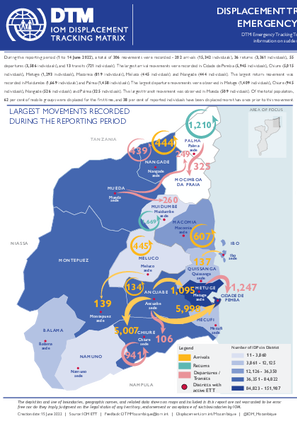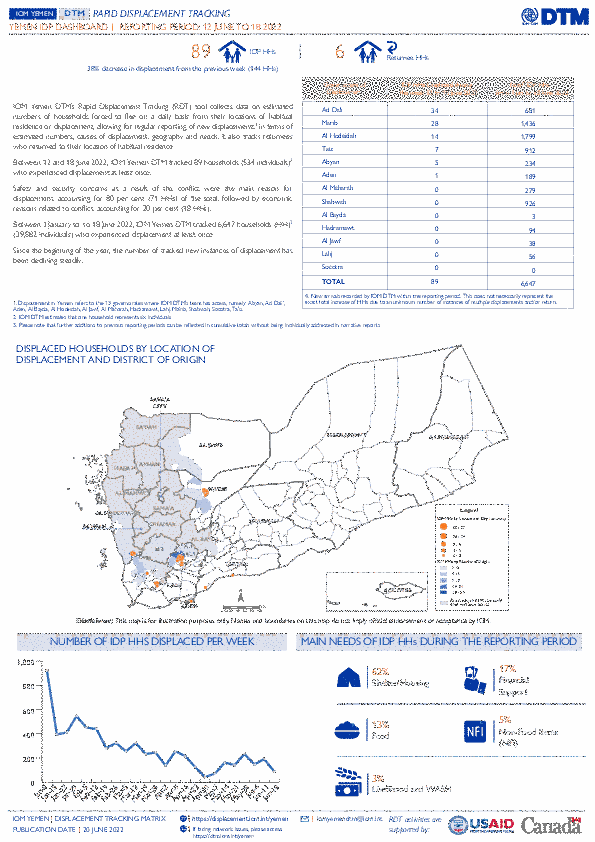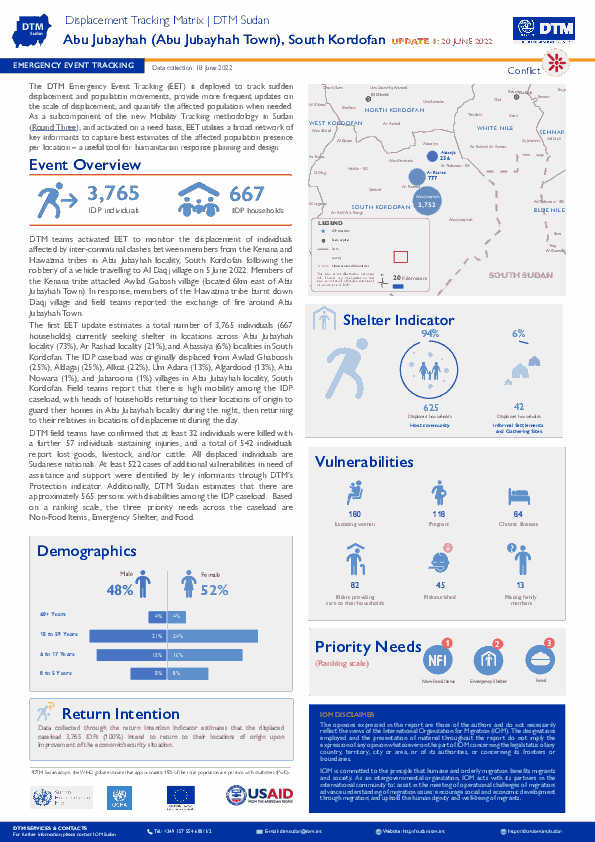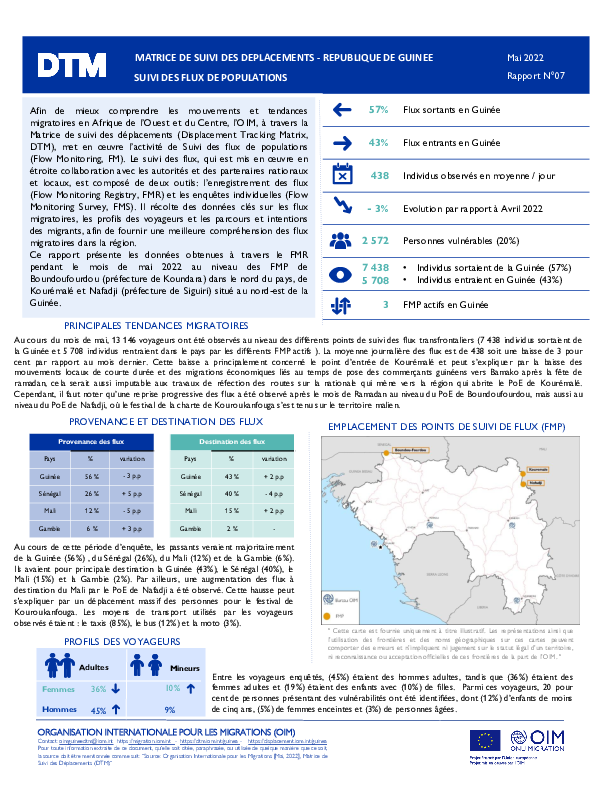-
Countries
-
Data and Analysis
-
Special Focus
-
Crisis Responses

Contact
DTMMozambique@iom.int
Language
English
Location
Mozambique
Period Covered
Jun 01 2022
Jun 14 2022
Activity
- Mobility Tracking
- Event Tracking
During the reporting period (1 to 14 June 2022), a total of 306 movements were recorded - 202 arrivals (15,342 individuals), 36 returns (3,361 individuals), 55 departures (3,586 individuals), and 13 transits (721 individuals). The largest arrival movements were recorded in Cidade de Pemba (5,945 individuals), Chiure (5,015 individuals), Metuge (1,293 individuals), Macomia (819 individuals), Meluco (445 individuals) and Nangade (444 individuals). The largest return movement was recorded in Muidumbe (1,669 individuals) and Palma (1,458 individuals). The largest departure movements were observed in Metuge (1,409 individuals), Chiure (945 individuals), Nangade (526 individuals) and Palma (325 individuals). The largest transit movement was observed in Mueda (509 individuals). Of the total population, 62 per cent of mobile groups were displaced for the first time, and 38 per cent of reported individuals have been displaced more than once prior to this movement.
Contact
DTM Yemen, iomyemendtm@iom.int
Location
Yemen
Activity
- Mobility Tracking
- Event Tracking
Period Covered
Jun 12 2022 -Jun 18 2022
IOM Yemen DTM’s Rapid Displacement Tracking (RDT) tool collects data on estimated numbers of households forced to flee on a daily basis from their locations of origin or displacement, allowing for regular reporting of new displacements in terms of estimated numbers, geography, and needs. It also tracks returnees who returned to their location of origin.
From 1 January to 18 June 2022, IOM Yemen DTM tracked 6,647 households (HH) (39,882 Individuals) who experienced displacement at least once.
Between 12 and 18 June 2022, IOM Yemen DTM tracked 89 households (534 individuals) displaced at least once. The majority of people moved into/within the following governorates and districts:
• Ad Dali (34 HHs) – Qatabah (22 HHs), Ad Dali (12 HHs) districts. Most displacements in the governorate originated from Ad Dali and Ibb.
• Marib (28 HHs) – Marib (17 HHs), Marib City (11 HHs) districts. Most displacements in the governorate originated from Marib and Al Hodeidah.
• Al Hodeidah (14 HHs) – Hays (14 HHs) district. Most displacements in the governorate were internal.
The majority of people moved from the following governorates and districts:
• Al Hodeidah (27 HHs) – Hays (15 HHs), Al Marawiah (3 HHs), Al Hali (3 HHs) districts.
• Ad Dali (17 HHs) – Qatabah (10 HHs), Al Husha (4 HHs), Ad Dali (1 HHs) districts.
• Taiz (11 HHs) – Maqbanah (5 HHs), Mawza (3 HHs), At Taiziyah (1 HHs) districts.
Population Groups
Survey Methodology
Unit of Analysis Or Observation
Type of Survey or Assessment
Keywords
Geographical Scope
Administrative boundaries with available data
The current dataset covers the following administrative boundaries

Contact
DTM Yemen, iomyemendtm@iom.int
Language
English
Location
Yemen
Period Covered
Jun 12 2022
Jun 18 2022
Activity
- Mobility Tracking
IOM Yemen DTM’s Rapid Displacement Tracking (RDT) tool collects data on estimated numbers of households forced to flee on a daily basis from their locations of origin or displacement, allowing for regular reporting of new displacements in terms of estimated numbers, geography, and needs. It also tracks returnees who returned to their location of origin.
From 1 January to 18 June 2022, IOM Yemen DTM tracked 6,647 households (HH) (39,882 Individuals) who experienced displacement at least once.
Between 12 and 18 June 2022, IOM Yemen DTM tracked 89 households (534 individuals) displaced at least once. The majority of people moved into/within the following governorates and districts:
- Ad Dali (34 HHs) – Qatabah (22 HHs), Ad Dali (12 HHs) districts. Most displacements in the governorate originated from Ad Dali and Ibb.
- Marib (28 HHs) – Marib (17 HHs), Marib City (11 HHs) districts. Most displacements in the governorate originated from Marib and Al Hodeidah.
- Al Hodeidah (14 HHs) – Hays (14 HHs) district. Most displacements in the governorate were internal.
The majority of people moved from the following governorates and districts:
- Al Hodeidah (27 HHs) – Hays (15 HHs), Al Marawiah (3 HHs), Al Hali (3 HHs) districts.
- Ad Dali (17 HHs) – Qatabah (10 HHs), Al Husha (4 HHs), Ad Dali (1 HHs) districts.
- Taiz (11 HHs) – Maqbanah (5 HHs), Mawza (3 HHs), At Taiziyah (1 HHs) districts.

Contact
DTMMozambique@iom.int
Language
English
Location
Mozambique
Period Covered
Jun 02 2022
Jun 16 2022
Activity
- Mobility Tracking
- Event Tracking
Fear of attacks and subsequent confirmed attacks in Ancuabe district by Non-State Armed Groups triggered the movements of 20,339 individuals within Ancuabe, Chiure, Quissanga, Balama, Mecufi, Mueda, Macomia, Montepuez, Meluco, Namuno, Nampula, Balama, Metuge and Cidade de Pemba. Approximately 927 IDPs have been identified with vulnerabilities. At
least 39% of these movements are arrivals in Cidade de Pemba and 29% in Chiure. New arrivals recorded within this report map 3,386 individuals predominantly moving into sites across Chiure, Metuge and Ancuabe.
The objective of the Emergency Tracking Tool (ETT) - Movement Alert is to collect information on large and sudden population movements, and to provide support to humanitarian response partners by disseminating data on IDPs for ensuring effective humanitarian response to the affected population. Information is collected through key informant interviews or direct observation. The dashboard provides basic information on displacements, and additional information can be shared upon request. IOM identified 17,691 individual displacement movements in the previous reporting period (02-15 June). Impact of new attacks reported between 9 and 13 June in Ancuabe and Chiure districts account for the increase of displacement movements representing 20,339 individuals. Current figures are to be considered as cumulative displacement movements observed between 02-16 June.

Contact
DTM Sudan; dtmsudan@iom.int
Language
English
Location
Sudan
Snapshot Date
Jun 18 2022
Activity
- Mobility Tracking
- Event Tracking
The DTM Emergency Event Tracking (EET) is deployed to track sudden displacement and population movements, provide more frequent updates on the scale of displacement, and quantify the affected population when needed. As a subcomponent of the new Mobility Tracking methodology in Sudan (Round Three), and activated on a need basis, EET utilises a broad network of key informants to capture best estimates of the affected population presence per location – a useful tool for humanitarian response planning and design.

Contact
DTM Cameroon, DTMCameroun@iom.int
Language
French
Location
Cameroon
Period Covered
Jun 12 2022
Jun 16 2022
Activity
- Mobility Tracking
- Event Tracking
L’objectif de l’outil de suivi des urgences est de rassembler des informations sur les mouvements significatifs et soudains de populations. Ce tableau de bord présente des informations sur des mouvements déplacements de personnes survenus entre le 12 et 16 juin 2022 dans la localité de Ndrock, arrondissement du Mokolo (département du Mayo-Tsanaga) dans la région de l’Extrême-Nord.

Contact
oimguineedtm@iom.int
Language
French
Location
Guinea
Period Covered
May 01 2022
May 31 2022
Activity
- Flow Monitoring
Afin de mieux comprendre les mouvements et tendances migratoires en Afrique de l’Ouest et du Centre, l’OIM, à travers la Matrice de suivi des déplacements (Displacement Tracking Matrix, DTM), met en œuvre l’activité de Suivi des flux de populations (Flow Monitoring, FM). Le suivi des flux, qui est mis en œuvre en étroite collaboration avec les autorités et des partenaires nationaux et locaux, est composé de deux outils: l’enregistrement des flux (Flow Monitoring Registry, FMR) et les enquêtes individuelles (Flow Monitoring Survey, FMS). Il récolte des données clés sur les flux migratoires, les profils des voyageurs et les parcours et intentions des migrants, afin de fournir une meilleure compréhension des flux migratoires dans la région.
Ce rapport présente les données obtenues à travers le FMR pendant le mois de mai 2022 au niveau des FMP de Boundoufourdou (préfecture de Koundara) dans le nord du pays, de Kourémalé et Nafadji (préfecture de Siguiri) au nord-est de la Guinée.

Contact
DTMcovid19@iom.int
Language
English
Location
Global
Period Covered
Jun 06 2022
Jun 13 2022
Activity
- Other
The DTM Global Mobility Restrictions Overview provides updates on international air travel restrictions and conditions for authorized entry. This overview aims to understand how COVID-19 has impacted human mobility, detailing how global and regional trends in air travel measures have evolved since COVID-19 was declared a global pandemic in March 2020. The data presented focuses on the changes in public health-related immigration and border management measures. It provides information intended to support IOM missions and partners in targeted response planning and advocacy for vulnerable populations who may be affected by changes in global mobility.
IOM works with national and local authorities in order to gain a better understanding of population movements throughout Southern Africa. Through the setup of Flow Monitoring Points (FMPs), IOM seeks to quantify migration flows, trends and routes and to gain a better understanding of the profiles of observed individuals at entry, transit or exit points (such as border crossing posts, bus stations, rest areas, police checkpoints and reception centres). This report is an overview of the data collected in these FMPs from 1 to 31 May 2022.
Inter-regional migration from and within the Southern Africa is categorized along the following corridors. The Flow Monitoring Points (FMPs) were set-up in several key transit locations along the corridors to track the movements of passengers:
•Zimbabwe (Mutare) – Mozambique (Manica)
•Zimbabwe – Zambia (Chirundu)
•Zimbabwe – Botswana (Plumtree)
•Zimbabwe (Beitbridge) – South Africa
•Malawi (Mchinji) - Zambia (Mwami)
•Malawi (Karonga ) – United Republic of Tanzania
•Malawi (Mwanza) – Mozambique (Zobue)
•Malawi (Mulanje) – Mozambique
•Mozambique (Ressano Garcia) – South Africa
Over the reporting period a total of 65,941 movements were observed across 48 FMPs in the region. The Zimbabwe – South Africa corridor hosted the largest number of movements with 34,798 (53%) followed by the Malawi (Mwanza) – Mozambique (Zobue) corridor with 10,134 (15%) and the Malawi – Zambia corridor with 6,453 movements reported (10%).

Contact
DTM Nigeria, AllUsersInDTMNigeria@iom.int
Language
English
Location
Nigeria
Period Covered
May 01 2022
May 31 2022
Activity
- Other
Farmers-Herdsmen conflicts are propelled by multi-causal factors, such as limited resources in the face of population increment and its attendant increment of needs, weakened traditional conflict resolving mechanisms and shortage of land, and climate change. These narratives and profiles have aided aggressive encroachment and reprisal aggression between the parties leading to mutual hostility and reverse-violent attacks. Further, tensions have grown with reports of violent clashes becoming more frequent, and in recent years, disputes over crop damage, livestock theft, and water pollution have increasingly turned violent.
To analyze the causes of the farmer-herder conflicts in Adamawa state, TTT Early Warning deploys a network of Key Informants selected from members of the Community Response Network (CRN) in the 5 operational LGAs in order to identify the pattern of alerts related to the use of transhumance movement.
Two hundred and eighty-seven (287) alerts were recorded by the TTT Early Warning tool for May 2022. These alerts were triangulated to consist of 255 (89%) events and 32 (11%) massive/sudden movements. The coverage of event alerts spread across 79 percent of the wards in the five (5) operational LGAs. Demsa LGA has the highest rate of events alert (36%), followed by Numan, Lamurde, Girei, and Mayo-Belwa at 26%, 21%, 10%, and 7%, respectively. Kodompti and Gyawana wards in Numan and Lamurde LGAs have the highest recorded event alerts of 38 and 23, respectively.
Areas identified as a high risk of conflict occurrence for the month under review are Jada1 and 2, Bare, Bille, Betso, Demsa, Gumti, Gwamba, Kodomti, Kpasham, Konkol, Lafiya, Lamurde, Mayo Farang, MayoInne, MayoKalaye, Shelleng, Vulpi, Yeli, Bebel, Gengle, Mbilla, Pallam, Guyuk wards. These present an essential early warning opportunity to monitor early or massive transhumance events and mitigate potential Agro-Pastoral conflicts in these locations.
